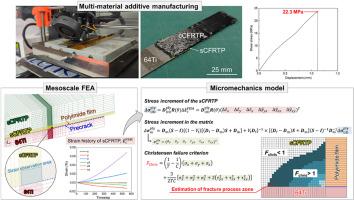Experimental and numerical evaluation of the interfacial adhesion properties of additively manufactured carbon-fiber-reinforced thermoplastic/64 titanium hybrids
IF 9.8
1区 材料科学
Q1 MATERIALS SCIENCE, COMPOSITES
引用次数: 0
Abstract
This study presents an integrated numerical–experimental approach to analyze the interfacial fracture behavior of carbon fiber-reinforced thermoplastic (CFRTP)/metal hybrid joints. A two-scale damage analysis framework is proposed, combining finite element analysis (FEA) for macroscopic stress evaluation with a micromechanics model incorporating Christensen's failure criterion. This methodology enables visualization of the fracture process zone (FPZ) and quantitative assessment of interfacial damage evolution. To validate the approach, hybrid joints consisting of short-fiber CFRTP (sCFRTP), continuous-fiber CFRTP (cCFRTP), and 64Ti substrates were fabricated using a modified fused filament fabrication process. A polyimide film was inserted between the sCFRTP and 64Ti substrate to introduce an artificial precrack, which promoted stress localization during lap-shear testing. The joints demonstrated a maximum shear strength of 22.3 ± 0.3 MPa, with fractographic analysis revealing cohesive failure within the sCFRTP layer. These results suggest that the primary bonding mechanism is mechanical interlocking due to melt infiltration into the sandblasted titanium surface. The two-scale simulation revealed an FPZ extending approximately 27 μm along the interface, in agreement with the observed fracture morphology near the precrack tip. This framework offers a predictive tool for understanding damage propagation in dissimilar-material joints and holds promise for the design of lightweight, high-strength CFRTP–metal hybrid structures in advanced manufacturing applications.

增材制造碳纤维增强热塑性塑料/64钛合金复合材料界面粘接性能的实验与数值评价
采用数值-实验相结合的方法分析了碳纤维增强热塑性塑料(CFRTP)/金属复合接头的界面断裂行为。提出了一种结合宏观应力分析的有限元分析和结合Christensen破坏准则的细观力学模型的双尺度损伤分析框架。该方法可以实现断裂过程区(FPZ)的可视化和界面损伤演化的定量评估。为了验证该方法,采用改进的熔丝制造工艺制备了由短纤维CFRTP (sCFRTP)、连续纤维CFRTP (cCFRTP)和64Ti基板组成的混合接头。在sCFRTP和64Ti衬底之间插入聚酰亚胺薄膜,引入人工预裂缝,促进了搭剪测试过程中的应力局部化。节理的最大抗剪强度为22.3±0.3 MPa,断口分析显示节理在sCFRTP层内发生了内聚破坏。结果表明,喷砂钛表面熔体渗透形成的机械联锁是主要的结合机制。双尺度模拟结果显示,沿界面延伸约27 μm的FPZ与预裂尖端附近观察到的断裂形貌一致。该框架为理解不同材料接头的损伤传播提供了预测工具,并有望在先进制造应用中设计轻质、高强度cfrtp -金属混合结构。
本文章由计算机程序翻译,如有差异,请以英文原文为准。
求助全文
约1分钟内获得全文
求助全文
来源期刊

Composites Science and Technology
工程技术-材料科学:复合
CiteScore
16.20
自引率
9.90%
发文量
611
审稿时长
33 days
期刊介绍:
Composites Science and Technology publishes refereed original articles on the fundamental and applied science of engineering composites. The focus of this journal is on polymeric matrix composites with reinforcements/fillers ranging from nano- to macro-scale. CSTE encourages manuscripts reporting unique, innovative contributions to the physics, chemistry, materials science and applied mechanics aspects of advanced composites.
Besides traditional fiber reinforced composites, novel composites with significant potential for engineering applications are encouraged.
 求助内容:
求助内容: 应助结果提醒方式:
应助结果提醒方式:


